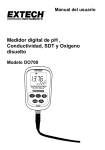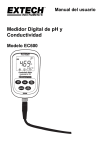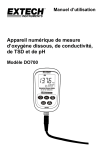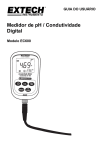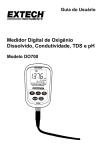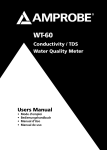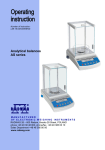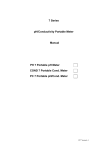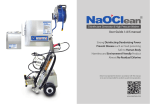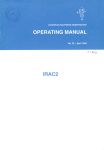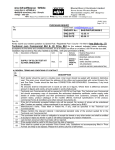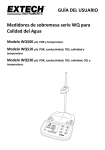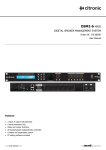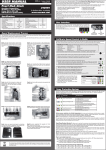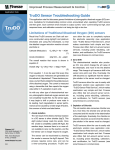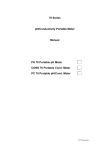Download Digital Dissolved Oxygen, Conductivity, TDS and pH Meter
Transcript
User's Guide Digital Dissolved Oxygen, Conductivity, TDS and pH Meter Model DO700 Introduction Congratulations on your purchase of the Extech DO700 meter. For best results, please read the entire manual before use. The DO700 measures Dissolved Oxygen (DO), Conductivity, pH, mV, and temperature parameters. Conductivity measurements also yield TDS (total dissolved solids), Salinity, and Resistivity readings. The built-in microprocessor provides automatic calibration, automatic temperature compensation, data storage, and self-diagnostics. The digital filter improves measurement speed and accuracy. The meter offers a backlit LCD display and is dust-proof and waterproof, meeting IP57. This meter is shipped fully tested and calibrated and, with proper use, will provide years of reliable service. pH Features The meter can recognize up to 13 types of pH standard buffer solutions. Two special pH modes (for distilled water and distilled water mixed with ammonia) are provided. These special modes offer general slope compensation and non-linearity solution temperature compensation suitable for the electric power and petrochemical industries. Conductivity Features Automatic frequency conversion and voltage regulation increases the Conductivity electrode range (K = 1 to 10 times). One point Conductivity calibration allows measurements from 0 to 100mS/cm. Up to 8 types of Conductivity standards can be recognized. The meter has an automatic range feature with non-linear temperature compensation for distilled water with Conductivity values lower than 10uS/cm greatly improving accuracy and suitable for the microelectronics and pharmaceutical industries. Dissolved Oxygen Features The latest technology DO electrode offers a temperature and salinity sensor with automatic temperature compensation and automatic salinity compensation as well as manual barometric pressure compensation. 2 DO700-EU-EN-V2.1-5/11 Supplied Equipment List • DO700 Meter • Dissolved Oxygen, Conductivity, and pH Electrode • Standard pH buffer solutions (4.00pH, 7.00pH, and 10.01pH) / 50ml • Standard Conductivity solution (1413µS/cm) / 50ml • Standard Dissolved Oxygen solution (30ml) • Dissolved Oxygen Membrane cap for DO electrode • Cathode polishing paper • Screwdriver (for removing battery compartment cover) • Batteries (2 x ’AA’ 1.5V) • User’s Guide • Carrying Case Meter Description 1. LCD Display (detailed in section below) 2. Rubber protective jacket (remove to access the rear battery compartment) 3. Keypad (detailed in section below) 4. Electrode connection jack 5. Electrode plug 6. Electrode cable 3 DO700-EU-EN-V2.1-5/11 Display Description 1. Measurement type icons 2. Measured reading 3. 888 (Stored data serial number), M+ (measurement to be stored icon), RM (reading to be recalled icon) 4. Units of measure 5. Temperature reading 6. Stable measurement icon 7. Calibration icons 8. Low battery icon Keypad Description ON/OFF Power Key Calibration Key a) When taking a measurement, press this key to enter the calibration mode b) When in the programming mode, press this key to change the displayed number or the ON/OFF state Mode Key a) In pH measuring mode, one short press switches between pH and mV measuring modes. One long press (>2s) enters the parameter setting mode. Subsequent presses will scroll through the available parameters. b) In other measuring modes, press to enter the parameter setting modes. The meter will scroll through the available parameters Backlight and ENTER Key a) In the measurement mode, momentary presses toggle the backlight on and off b) When in the programming or calibration mode, press to ENTER data c) When in the pH mode, press and hold to change the resolution 0.01 to 0.1pH d) When in the Conductivity mode, press and hold to scroll through the TDS, Salinity, Resistivity, and Conductivity modes e) When in DO mode, press and hold to select the unit of measure (mg/L > ppm > %). Release the key when the desired unit is displayed MEMORY STORE and RECALL Key a) In the measurement mode, momentary presses store the displayed readings. Press and hold for at least 2 seconds to recall a saved reading b) In programming mode, press to change the displayed number or ON/OFF state 4 DO700-EU-EN-V2.1-5/11 Store, Recall, and Clear Datalogger Memory STORE Readings The meter can store up to 100 DO, 100 pH, 100 mV, and 100 Conductivity readings for a total of 400 data points. To store a reading, wait until the reading stabilizes (the smiling face icon appears when the reading stabilizes). Press the M+/RM key momentarily to store a reading. The M+ icon appears and the data point serial number increments. RECALL Readings In the measurement mode, press the M+/RM key to recall the most recently stored reading. RM and the data point serial number for the displayed reading will appear on the LCD. The measurement information will appear on the lower right hand side of the LCD. Use the CAL or M+/RM buttons to scroll the remaining stored readings. Press the ENTER key to return to the normal measurement mode. CLEAR Readings From the RECALL mode, press and hold the ENTER key for at least five (5) seconds. The LCD display will show ‘CLR’ indicating that all of the stored readings have been erased. The unit will automatically return to the normal measurement mode after approximately 2 seconds. 5 DO700-EU-EN-V2.1-5/11 pH Measurement Mode Preparation for Measurement 1. Unscrew the protective cap on the probe jack located on the bottom of the meter (store the protective cap in the carrying case for later use). 2. Carefully connect the pH probe to the meter’s probe jack. The probe can only be inserted in one orientation. Once it is firmly connected, screw the probe collar onto the meter to secure the probe. 3. Turn the meter on using the power key . 4. Press the MODE key momentarily to switch to the pH mode only if the meter is in the mV mode. Otherwise, the unit of measure should already display pH units. 3-Point Calibration (7.00pH, 4.00pH and 10.01pH) 1. Press the CAL key to enter the Calibration mode. The meter’s display will show a blinking ‘C1’ 2. Rinse the probe in distilled water, allow it to dry, and submerge it into a pH 7.00 buffer solution. Stir the solution briefly and allow it to stay in the buffer solution until a stable reading is reached 3. Press CAL again and the display will show a blinking ‘7.00’ 4. This portion of the calibration procedure is complete when the display stops blinking and shows the ‘C2’ icon. The unit will automatically switch to the second point of the calibration 5. Rinse the probe in distilled water again, allow it to dry, and submerge it into a pH 4.00 buffer solution. Stir the solution briefly and allow it to stay in the buffer solution until a stable reading is reached 6. Press CAL again and the display will show a blinking ‘4.00’ 7. This portion of the calibration procedure is complete when the display stops blinking and shows the ‘C3’ icon. The unit will automatically switch to the third point of the calibration 8. Rinse the probe in distilled water again, allow it to dry, and submerge it into a pH 10.01 buffer solution. Stir the solution briefly and allow it to stay in the buffer solution until a stable reading is reached 9. Press CAL again and the display will show a blinking ‘10.01’ 10. After the display stabilizes the 3-point calibration icon will appear 1-Point and 2-Point Calibration A one or two point calibration is acceptable if the expected measurement result is known. For example, if the expeced pH is 4pH, it is acceptable to perform only a 1-Point Calibration (4pH). If the expected measurement is between 4.00pH and 7.00pH, the user can perform a 2-Point Calibration (4.00 and 7.00pH), and so on. For a 4pH calibration, only the circled L will appear on the LCD. For a 7.00pH, only the circled M will appear on the LCD. For a 10.01pH Calibration, only the circled H will appear (Low, Medium, and High). For all other applications, a 3-Point Calibration is recommended. Always perform a 3-Point Calibration on new probes and probes that have been in use for long periods. This maximizes measurement slope linearity. Press the ENTER key to exit the Calibration mode. 6 DO700-EU-EN-V2.1-5/11 Testing the pH of a Sample 1. Perform the pH Calibratoin as described above 2. Rinse and dry the pH Probe and submerge it in a sample liquid 3. Stir the solution briefly with the probe and allow it to stand until the display stabilizes 4. Note that the closer the temperature of the sample solution to the calibration solution, the more accurate readings Programming pH Parameters The Table below shows the available programming menu items P1 ~ P7. Each parameter is explained in detail in the subsequent sections. Parameters P1 P2 P3 Code sol pH buffer solution series selection Distilled water pH temperature compensation setting (see notes below this Table) Distilled water with Ammonia pH temperature compensation setting (see Notes below this Table) Selections USA (Europe & U.S.A) NIS (NIST) CH (China) OFF / ON OFF / ON P4 Temperature unit setting ℃/℉ P5 Back light display time setting 0-1-3-6min P6 Auto power off setting 0-10-20min P7 Restore to default factory settings OFF / ON Notes on P2 and P3 Parameters: Measurements of distilled water and distilled water mixed with ammonia affect the temperature compensation and the slope linearity of the pH probe. Such measurements are sometimes used in the electrical power and petrochemical industries. Set these parameters to ON only if necessary, otherwise leave these parameters in the OFF state. 7 DO700-EU-EN-V2.1-5/11 Parameter P1 (pH Buffer Solution Setting) 1. From the pH measurement mode, press and hold MODE for at least 2 seconds and then release, the ‘P1’ icon appears on the LCD. 2. Use the CAL or the M+/RM keys to toggle through the three (3) selections: USA (for use in the USA or Europe, NIS (for NIST calibration purposes), and CH (for use in China). 3. Momentarily press MODE to move to the next parameter (P2), or press ENTER to return to the normal measurement mode. Parameter P2 (Distilled Water Temperature Compensation Setting) 1. From the P2 menu, use the CAL or the M+/RM keys to turn this feature ON or OFF. 2. Momentarily press MODE to move to the next parameter (P3), or press ENTER to return to the normal measurement mode. Parameter P3 (Distilled Water with Ammonia Temperature Compensation Setting) 1. From the P3 menu, use the CAL or the M+/RM keys to turn this feature ON or OFF. 2. Momentarily press MODE to move to the next parameter (P4) or press ENTER to return to the normal measurement mode. Parameter P4 (Temperature Measurement Units Setting) 1. From the P4 menu, use the CAL or the M+/RM keys to turn this feature ON or OFF. 2. Momentarily press MODE to move to the next parameter (P5) or press ENTER to return to the normal measurement mode. Parameter P5 (Display Backlight Setting) 1. From the P5 menu, use the CAL or the M+/RM keys to select 0, 1, 3, or 6 minute default backlighting time. 2. Momentarily press MODE to move to the next parameter (P6) or press ENTER to return to the normal measurement mode. Parameter P6 (Automatic Power OFF Setting) 1. From the P6 menu, use the CAL or the M+/RM keys to select a 0, 10, or 20 minute Auto Power OFF time. 2. Momentarily press MODE to move to the next parameter (P7) or press ENTER to return to the normal measurement mode. Parameter P7 (Restore Factory Default Settings) 1. From the P7 menu, use the CAL or the M+/RM keys to select ON (reset the factory default settings) or OFF (cancel edit). 2. Momentarily press MODE to move to the first parameter (P1) or press ENTER to return to the normal measurement mode. 8 DO700-EU-EN-V2.1-5/11 pH Measurement, Calibration, and Electrode Considerations • Error messages ERR-1: Electrode zero potential error and ERR-2: Electrode slope error; For either error, check the following: 1. Air bubbles in the electrode bulb. Shake rigorously to remove air bubbles 2. Accuracy of the pH buffers used in calibration. Replace buffers if necessary 3. Set meter to its factory default state in Parameter P7 (previous section of manual) • Calibration intervals depend on the sample, the electrode performance, and the required accuracy. For high accuracy measurements (≤ ±0.02pH), the meter should be calibrated immediately before taking a measurement. For general accuracy (≥±0.1pH), the meter can be calibrated and used for approximately one week before the next calibration. • The meter must be recalibrated in the following situations: 1. New probe, or probe that is unused for a long period of time 2. After measuring acids (pH<2) or alkaline solutions (pH>12) 3. After measuring a solution that contains fluoride or a concentrated organic solution 4. If the solution’s temperature differs widely from the calibration solution temperature • The soaking solution contained in the supplied protective bottle is used to maintain activation in the glass bulb and junction. Loosen the capsule, remove the electrode and rinse in distilled water before taking a measurement. Insert the electrode and tighten the capsule after measurements to prevent the solution from leaking. If the soak solution is turbid or moldy, replace the solution. • To prepare a soak solution: Use 25g pure KCL dissolved with purified water and diluted to 100mL. The electrode should not be soaked in a distilled water protein solution or an acid fluoride solution for long periods of time. In addition, do not soak the electrode in organic silicon lipids. • For calibration accuracy, the pH of the standard buffer solution must be reliable. The buffer solution should be refreshed often, especially after heavy use. • For best accuracy, always keep the meter clean and dry, especially the meter’s electrode and electrode jack. Clean with medical cotton and alcohol if necessary. • The sensitive glass bulb at the front of the combination electrode should not come in contact with hard surfaces. Scratches or cracks on the electrode will cause inaccurate readings. Before and after each measurement, the electrode should be washed with distilled water and dried. Do not clean the glass bulb with a tissue for it will affect the stability of the electrode potential and increase the response time. The electrode should be thoroughly cleaned if a sample sticks to the electrode. Use a solvent if the solution does not appear clean after washing. • Electrodes that have been used over a long period of time, used in a strong solution that has damaged the sensitive bulb, or used with a substance resulting in a jam at the junction will be become passivated; the sensitivity will decrease, its response will slow, and the readings will be inaccurate. Replace the electrode as soon as possible in these cases. • For abnormal readings, try calibrating again; if the problem persists replace the Electrode. The user can also try resetting the meter to factory default conditions per Parameter P7 (detailed in an earlier section). Electrode life can be shortened by heavy use, extreme conditions, and improper maintenance. 9 DO700-EU-EN-V2.1-5/11 mV Measurement Mode 1. Unscrew the protective cap on the probe jack located on the bottom of the meter (store the protective cap in the carrying case for later use). 2. Carefully connect the pH probe to the meter’s probe jack. The probe can only be inserted in one orientation. Once it is firmly connected, screw the probe collar onto the meter to secure the probe. . 3. Turn the meter on using the power key 4. Press the MODE key momentarily to switch to the mV mode. 5. Immerse the electrode in the sample solution, slowly stir the solution with the electrode and then allow it to rest in the solution. 6. When the smile face icon appears on the LCD, the reading has stabilized. mV Programming Parameters Prompt Parameters Code Settings P1 Back light display time 0 -1-3-6 min P2 Auto power off time 0 -10-20 min Parameter P1 (Display Backlight Setting) 1. Press MODE to access the P1 Parameter. 2. Use the CAL or the M+/RM keys to select 0, 1, 3, or 6 minute default backlighting time. 3. Momentarily press MODE to move to the next parameter (P2) or press ENTER to return to the normal measurement mode. Parameter P2 (Automatic Power OFF Setting) 1. From the P2 menu, use the CAL or the M+/RM keys to select a 0, 10, or 20 minute Auto Power OFF time. 2. Momentarily press MODE to move back to Parameter P1, or press ENTER to return to the normal measurement mode. 10 DO700-EU-EN-V2.1-5/11 Conductivity Measurement Mode Preparation for Measurement 1. Unscrew the protective cap on the probe jack located on the bottom of the meter (store the protective cap in the carrying case for later use). 2. Carefully connect the electrode to the meter’s input jack. The electrode can only be inserted in one orientation. Once it is firmly connected, screw the electrode collar onto the meter to secure it. 3. Turn the meter on using the power key . 4. Press and hold the ENTER key to select the desired mode: Conductivity, TDS (Total Dissolved Solids), Salinity, or Resistivity. Calibration 1. Press the CAL key and ‘CAL’ will appear flashing on the LCD. 2. Clean and dry the conductivity electrode (use distilled water to clean). 3. Immerse the electrode in the 1413μS/cm calibration solution. 4. Stir the solution with the electrode and allow it to rest in the solution until the stabilize icon ( appears. ) 5. Press CAL again and the display will flash ‘1413μS/cm’; After several seconds the ‘END’ icon will appear and the meter will return to the measuring mode. 6. The LCD will display the icon ‘M’, indicating that the calibration is complete. 7. If the measurement value is unstable, repeat the calibration until the measurement is stable. Replace the electrode if necessary. Notes: The meter is calibrated before leaving the factory and can generally be used right out of the box. The meter can only be calibrated in the Conductivity mode and not from the TDS, Salinity, or Resistivity modes. Measuring the Conductivity of a Sample 1. Clean and dry the conductivity electrode and immerse in the sample solution. 2. Stir the solution and allow the electrode to rest in the solution until the reading stabilizes (smile face icon appears). 3. Read the conductivity measurement on the meter’s display. 5. Press and hold the ENTER key to select TDS (Total Dissolved Solids), Salinity, Resistivity, or Conductivity measurement modes. Calibration Considerations This meter offers two calibration solution series (configurued in Parameter P1). (a) (Europe & U.S.A. series) — 84μS/cm, 1413μS/cm, 12.88 mS/cm and 111.9 mS/cm (b) (China series) — 146.6μS/cm, 1408μS/cm, 12.85mS/cm and 111.3 mS/cm The DO700 offers a unique one-point calibration feature. The user can select the calibration solution closest to the expected measuremnt value. In general the most common calibration solution is 1413 μS/cm. Use the supplied conductivity electrode (K = 1 cm-1), and perform the calibration using the supplied 1413 μS/cm calibration solution. The meter can then be used for measurements below 100 mS/cm. Please refer to the chart below. 11 DO700-EU-EN-V2.1-5/11 Measuring range 0.05 to 20μS/cm Electrode constant K=0.1cm Calibration solution 84μS/cm -1 0.5μS/cm to 200mS/cm (flow test) K=1.0cm 84μS/cm -1 1413μS/cm 12.88 mS/cm 111.9 mS/cm Calibration indicator L L M H There are two electrode calibration methods: Standard Solution calibration and Constant calibration. The calibration described above in the section Calibration refers to the Standard Solution method (the most accurate calibration method, assuming the calibration buffer standard is accurate and fresh). To select the Constant calibration method use Parameter P5 described below in the Programming Parameters – Conductivity section. The temperature compensation coefficient of the meter setting is 2.0%. However, the conductivity temperature coefficient is different for solutions of a different variety and concentration. Use the chart below for common solution types (use Parameter P4 as described below in the Programming Parameters – Conductivity section). The meter can perform an automatic non-linear temperature compensation in distilled water for readings below 10 μS/cm. Note: When the coefficient for the temperature compensation is set to 0.00 (no compensation), the measurment value will be based on the current temperature. Solution Temperature compensation coefficient NaCl salt solution 2.12% 5%NaOH solution 1.72% Dilute ammonia solution 1.88% 10% hydrochloric acid solution 1.32% 5% sulfuric acid solution 0.96% Important Note: When one or more of the programmable parameters is changed by the user from its original factory default condition, the parameter’s code shown below, is displayed in the upper right corner of the display as shown in diagram below (in this case, Parameter P Tcc). If more than one parameter is changed, only the code from the first parameter change is displayed. 12 DO700-EU-EN-V2.1-5/11 Programming Parameters - Conductivity The Table below shows the available programming menu items P1 ~ P9. Each parameter is explained in detail in the subsequent sections. Parameters Code Selections P1 Standard solution series selection sol USA (Europe & U.S.A) CH (China) P2 Electrode Constant selection 0.1, 1, or 10 P3 Reference Temperature selection 77, 68, and 64 F (25, 20,and 18 ℃) P4 Temperature compensation coefficient setting 0.00 to 9.99% P5 Electrode Constant Calibration P6 Temperature units ℃℉ P7 Back light display time setting 0-1-3-6min P8 Auto power off setting 0-10-20min P9 Restore to default factory settings OFF / ON o Parameter P1 (Conductivity Solution Setting) 1. From the Conductivity mode, press the MODE key, the ‘P1’ icon appears on the LCD. 2. Use the CAL or the M+/RM keys to toggle through the two (2) selections: USA (for use in the USA or Europe) and CH (for use in China). 3. Momentarily press MODE to move to the next parameter (P2), or press ENTER to return to the normal measurement mode. Parameter P2 (Electrode Constant ‘K’ Selection) 1. From the P2 menu, use the CAL or the M+/RM keys to select the desired electrode constant (0.1, 1.0, or 10). The default setting is K=1.0. 2. Momentarily press MODE to move to the next parameter (P3), or press ENTER to return to the normal measurement mode. 13 DO700-EU-EN-V2.1-5/11 Parameter P3 (Reference Temperature Selection) 1. From the P3 menu, use the CAL or the M+/RM keys to select the desired reference temperature (25, 20, or 18℃).The default setting is 25℃ 2. Momentarily press MODE to move to the next parameter (P4) or press ENTER to return to the normal measurement mode Parameter P4 (Temperature Coefficient Temperature Compensation Setting) 1. From the P4 menu, use the CAL or the M+/RM keys to select the coefficient in percent from 0.00 to 9.99. When set to zero, the temperature compensation is turned OFF. The default setting is 2.0% 2. Momentarily press MODE to move to the next parameter (P5) or press ENTER to return to the normal measurement mode Parameter P5 (Electrode Constant calibration) 1. In the P5 window the user can see the existing constant in the main measurement area of the -1 LCD in cm units 2. From the P5 menu, use the CAL or the M+/RM keys to change the constant to match the constant printed on the electrode housing 3. Momentarily press MODE to move to the next parameter (P6) or press ENTER to return to the normal measurement mode Parameter P6 (Temperature units of measure) 1. From the P6 menu, use the CAL or the M+/RM keys to select the desired unit of measure (C or F) 2. Momentarily press MODE to move to the next parameter (P7) or press ENTER to return to the normal measurement mode Parameter P7 (Display Backlight Setting) 1. From the P7 menu, use the CAL or the M+/RM keys to select 0, 1, 3, or 6 minute default backlighting time 2. Momentarily press MODE to move to the next parameter (P8) or press ENTER to return to the normal measurement mode Parameter P8 (Automatic Power OFF Setting) 1. From the P8 menu, use the CAL or the M+/RM keys to select a 0, 10, or 20 minute Auto Power OFF time 2. Momentarily press MODE to move to the next parameter (P9) or press ENTER to return to the normal measurement mode Parameter P9 (Restore Factory Default Settings) 1. From the P9 menu, use the CAL or the M+/RM keys to select ON (reset the factory default settings) or OFF (cancel edit). Note that the instant the ON selection is made the meter will revert to its factory default state and all user settings will be cleared. Only select ON if absolutely necessary. 2. Momentarily press MODE to move to the first parameter (P1) or press ENTER to return to the normal measurement mode 14 DO700-EU-EN-V2.1-5/11 Conductivity Measurement, Calibration, and Maintenance Considerations • The meter and probe are calibrated before leaving the factory; the user can take measurements immediately upon receiving the unit. • The recommend calibration period is once per month under normal circumstances; It is necessary to calibrate a newly purchased conductivity electrode or one that has been in service for a long period of time. • Keep the conductivity electrode clean. It’s best to rinse electrodes with the sample solution. • The surface of the supplied conductivity electrode is plated with a layer of platinum (black) in order to lower the electrode polarization and increase the measuring range. Do not polish the black platinum surface; clean it by stirring in Distilled water. If excessive organic buildup appears on the black platinum coating clean with hot water and detergent or with alcohol. • Replace the electrode if the above cleaning methods are ineffective. • Reset the meter to its factory default settings (Parameter P9) if unusual operation is noticed. If the reset process does not solve the issue, return the unit for an evaluation. 15 DO700-EU-EN-V2.1-5/11 Dissolved Oxygen (DO) Measurements Preparation • Remove the DO electrode from the solution bottle. • Determine if the sponge inside the bottle is moist. If not, moisten the sponge but do not allow excess water in the bottle. • Small air bubbles are acceptable in the electrode but larger air bubbles should be removed. To do so, remove the membrane cap and add electrolyte. Connect the electrode to the meter and allow for a 15-minute polarization. • Press the power key to turn on the meter (the DO indicator should appear). • Press and hold the ENTER key to select the desired unit of measure (mg/L, ppm, %); then release. 1. DO electrode 2. Calibration cover cap 3. Calibration cover 4. Water soaked sponge 5. Calibration cover bottom 6. Temperature electrode 7. Membrane cap 8. Cathode (gold) 9. Anode 10. Salinity electrode Calibration • Use the percentage (%) unit of measure for calibration. • Press the CAL key to enter the Calibration mode (the flashing CAL icon will appear on the meter’s LCD). • Put the DO electrode into the calibration solution (calibration container that the probe was housed in upon delivery) and tightly secure the cap of the calibration solution, place vertically and allow polarizing for 3 to 5 minutes. • When the reading stabilizes the smile face icon again. • The LCD will display a flashing ‘100%’ indicating that the calibration is complete. After several seconds the meter will display ‘END’ and return to the measuring mode. • If the displayed reading does not stabilize, polarize again per the Preparation section above, and retry this calibration procedure. 16 appears on the LCD. Press the CAL key DO700-EU-EN-V2.1-5/11 Dissolved Oxygen Water Sample Test • To measure moving water (water sample velocity of flow >5cm/s) insert the DO electrode into the water. The water surface should cover the electrode’s thermistor (temperature sensor). The recommended electrode orientation with regard to the water is a 45°to 75°angle. Move the electrode around in the water and allow 3 to 5 minutes to take the reading. • To measure in static water: Insert the DO electrode into water, water surface should cover the location of the electrode’s thermistor (temperature sensor), the direction for the electrode with respect to the water is a 45°to 75°angle. Quickly stir the electrode in water at a speed >5cm/s. Allow 3 to 5 minutes while taking the reading. • To test in slower flowing water: Use the first method above but stir the electrode faster in the water. Dissolved Oxygen Measurement and Calibration Considerations • The air temperature and water temperature should be within 10 degrees C, if the temperature difference is greater, please immerse the electrode in the sample water for 10 minutes and then calibrate. • After each start-up, the electrode must be polarized and a calibration must be performed; do not turn the meter OFF (when in the DO mode, the default auto power off time is zero). • During DO tests, the temperature affects the measurement greatly. The electrode’s thermistor should come in direct contact with the water sample. Please allow 3 to 5 minutes for the thermistor to gage a stable temperature measurement. • DO measurements are also greatly affected by Barometric pressure. The DO700 meter has an automatic Barometric pressure compensation function. • The DO electrode must not be left static in the test solution. Always stir the electrode in the solution. • When measuring, remove air bubbles from the solution under test otherwise measurement accuracy will be compromised. • Small air bubbles in the electrode’s electrolyte are acceptable; however larger bubbles must be removed. • Keep the surface of the DO electrode moist to protect the cathode electrolyte. The supplied storage sponge should always be kept moistened for proper storage. • The salinity electrode is installed in the DO electrode. Its surface is plated with a layer of platinum (black) to reduce electrode polarization. This surface must not be rubbed or wiped (clean by swirling it in water). Wash organic matter off of the surface with lukewarm water containing detergent or use alcohol if necessary. • For any display abnormalities while measuring or calibrating, set the meter to its factory default settings using parameter P7 (explained in next section). If abnormalities persist, the electrode most probably needs replacing. 17 DO700-EU-EN-V2.1-5/11 Parameter Settings Prompt Parameters Code Selections P1 Resolution selection 0.01/0.1(mg/L and ppm) 0.1/1(%) P2 Salinity calibration P3 Barometric pressure setting P4 Temperature unit setting P5 Back light display time setting 0-1-3-6 min P6 Auto power off time setting 0-10-20 min P7 Restore to producer setting OFF-On (shut-set) Refer to explanation below 66 to 200kPa o o C/ F P1 - Resolution selection • Press the MODE key to enter the P1 parameter mode. • Use the CAL key to select the resolution: 0.01→0.1; • Press the MODE key to enter into the next parameter setting or press ENTER to return to the normal measurement mode. P2 - Salinity Auto-Compensation • From the P1 parameter, press the MODE key to enter P2. • Immerse the DO electrode in the 12.88mS/cm calibration solution (the solution level should cover the electrode). After stirring, allow the electrode to rest in the solution and press the CAL key. When the value stabilizes, the smile face icon appears on the LCD along with a flashing “12.9”. The calibration will finish after several minutes and will display a stable value. • Press the MODE key to enter the next parameter or press ENTER to confirm and return to the measuring mode. P3 – Manual Barometric Pressure setting • From P2, press the MODE key to enter P3, the LCD will display the current barometric pressure value (unit of measure is kPa), for example, 101.3kPa. • Use the CAL or RM key to change the setting (refer to the standard Barometric pressure table). Press and hold CAL or RM to quickly scroll the value. • Press MODE to move to the next parameter or press ENTER to confirm and return to the measuring mode. 18 DO700-EU-EN-V2.1-5/11 P4 - Temperature unit of measure selection o o • Use the CAL or the M+/RM keys to select the desired unit of measure ( C or F). • Momentarily press MODE to move to the next parameter or press ENTER to return to the normal measurement mode. P5 - Display Backlight Setting • Use the CAL or the M+/RM keys to select 0, 1, 3, or 6 minute default backlighting time. • Momentarily press MODE to move to the next parameter or press ENTER to return to the normal measurement mode. P6 - Automatic Power OFF Setting • Use the CAL or the M+/RM keys to select a 0, 10, or 20 minute Auto Power OFF time. • Momentarily press MODE to move to the next parameter or press ENTER to return to the normal measurement mode. Note: The default setting for DO is 0, that is, the auto power off function is defeated. P7 - Restore Factory Default Settings • Use the CAL or the M+/RM keys to select ON (reset the factory default settings) or OFF (cancel edit). • Momentarily press MODE to move to the first parameter (P1) or press ENTER to return to the normal measurement mode. Replacing the Membrane Cap Replace the Membrane cap under the following conditions: • Electrode response time increases. • Displayed value appears incorrect or abnormal. • Damaged or cracked membrane. Replace as follows: 1. Loosen and then remove the membrane cap. 2. Clean the electrode (without membrane cap) with distilled water and shake the water off of the electrode. 3. Lightly polish the cathode surface (gold) with a piece of clear velvet or tissue. 4. Slowly inject electrolyte into a new membrane cap. After injecting, check the electrolyte for air bubbles. If air bubbles are present, carefully tap the membrane cap to remove the air pockets. 5. Place the membrane cap on a clean surface and place the electrode in the cap vertically. Slowly twist in a clockwise motion until electrode is tightly attached. Excess electrolyte may be displaced, wipe excess electrolyte with tissue and distilled water. 6. Check that there are no air bubbles present in the electrolyte (smaller air bubbles are acceptable). If large air bubbles are present, re-assembly will be required. 7. Do not touch the sensitive membrane when using the electrode or replacing the membrane cap. Oils from the skin will affect the quality of the membrane and decrease the rate of oxygen permeability. 19 DO700-EU-EN-V2.1-5/11 Zero Dissolved Oxygen Calibration The meter receives a zero oxygen calibration before leaving the factory and only requires a zero oxygen calibration when the electrode (or the electrode cap) is replaced or has been in use for a relatively extended period of time (6 months or longer). To perform a zero oxygen calibration: 1. Prepare 100mL of anaerobic water: In a 100 mL beaker add 5g anhydrous sodium sulfite (Na2SO3) to 100 mL distilled water. Stir to dissolve. The anaerobic water will be usable in 24 hours. 2. Polarize the DO electrode by connecting it into meter for 15 minutes and then perform a standard calibration as described in the calibration section earlier in this manual. 3. Place the electrode in the anaerobic water and press the CAL key to enter the calibration mode. When the displayed value is ≤ 0.15mg/L (≤5min) press the ENTER key. 4. If the displayed value is ≤0.02mg/L (within 5 minutes), this indicates that the response time and the residual current are normal and there is no need to perform the zero oxygen calibration, press the ENTER key to the normal operating mode. 5. If the displayed value is >0.15 mg/L after 5 minutes, this indicates that the response time of the meter is too slow and there is too much residual current. In this case, replace the membrane cap or remove the membrane cap and use the supplied polishing paper to lightly wipe the gold plane’s cathode (the surface along the gold-polished arc) and clean the surface of the cathode with a soft cloth or tissue. Clean the electrode with distilled water and shake off the excess water. Add some electrolyte to the membrane cap, re-assemble, and then perform a full scale and a zero oxygen calibration. Salinity Calibration Under normal circumstances, a salinity calibration is not required. The meter is equipped with an automatic salinity compensation; In addition, a salinity calibration has been performed at the factory prior to shipment; however a salinity calibration is required when the electrode is replaced or has been in service for a relatively extended period of time. Refer to parameter P2 in previous section for calibration procedure. Barometric Pressure Setting The meter is equipped with a manual barometric pressure adjustment. It is recommended that the value be set according to the standard barometric pressure table when there is an excessive change in barometric pressure while using meter. This ensures the accuracy of the barometric pressure compensation. To change the barometric value refer to parameter P3 in the previous section. Use the Table in Appendix C for barometric pressure values. You, as the end user, are legally bound (EU Battery ordinance) to return all used batteries, disposal in the household garbage is prohibited! You can hand over your used batteries / accumulators at collection points in your community or wherever batteries / accumulators are sold! Disposal: Follow the valid legal stipulations in respect of the disposal of the device at the end of its lifecycle 20 DO700-EU-EN-V2.1-5/11 Specifications pH Specifications Measuring range Resolution Accuracy Input current Input impedance Stability Temp. Compensation range -2.00 to 19.99 pH 0.1/0.01 pH Meter only: ±0.01pH; with probe: ±0.02pH -12 ≤2×10 A 12 ≥1×10 Ω ±0.01 pH/3h o o 0 to 100 C (32 to 212 F); Automatic (ATC) mV Specifications Measuring range (mV/EH) Resolution Accuracy -1999 mV to 0 to 1999mV 1mV Meter: ±0.1% FS Conductivity Specifications Conductivity measuring ranges TDS measurement range Salinity measurement range Resistivity Resolution Accuracy Electrode constant Reference temperatures Temp. Compensation range 0.00 to 19.99 µS/cm 20.0 to 199.9 µS/cm 200 to 1999 µS/cm 2.00 19.99 mS/cm 20.0 to 199.9 mS/cm 0 to 100 g/L (TDS: Total Dissolved Solids) 0 to 100 ppt 0 to 100 Mohms 0.01/0.1/1 µS/cm and 0.01/0.1mS/cm Meter only: ±1% F.S.; with probe: ±2% F.S. -1 0.1 / 1 / 10 cm o o 25, 20, and 18 C (77, 68, and 64 F) o o 0 to 50 C (32 to 122 F); Automatic (ATC) Dissolved Oxygen Measuring range Resolution Accuracy Response time Residual current Temp. compensation range Salinity compensation range Barometric pressure Electrode type (0 to 40.00) mg/L (ppm) (0 to 200.0) % 0.1/0.01 mg/L (ppm) 1/0.1 % Meter: ±0.10 mg/L; with electrode: ±0.40 mg/L o ≤30 s (25 C, 90% response) ≤0.1 mg/L o o 0 to 45 C (32 to 112 F); Automatic (ATC) 0 to 45 ppt; Automatic 66 to 200 kPa (Manual compensation) Polarogram type Other Technical Parameters Data storage Storage content Power Size and weight Quality/Safety certification 400 data groups Data serial number, measurement, & unit of measure Two ‘AA’ batteries (1.5V) Meter: 65 × 120 × 31mm (2.6 x 4.7 x 1.2”) / 180g (6.3 oz) Case: 360 x 270 x 76mm (14.1 x 10.6 x 3”) / 1.6kg (3.4 lbs) ISO9001, CE and CMC Ambient Conditions Environment temperature Environmental humidity IP rating o o 5 to 35 C (41 to 95 F) ≤85% IP57 Dustproof and waterproof 21 DO700-EU-EN-V2.1-5/11 Appendices Appendix A - Abbreviation Glossary Code or Abbreviation Translation Description Solution Standard solution Chinese Chinese series standard USA Europe / USA series standard NIST NIST series standard Pure1 pH Temperature compensation setting for Distilled Water Pure2 pH Temperature compensation setting for Distilled Water with Ammonia Constant Electrode constant setting Temperature Compensation Coefficient Setting for temperature compensation coefficient Reference Temperature Reference temperature setting Constant Calibration Calibration that uses a constant for reference rather than a solution End Calibration Conductivity Dissolved Oxygen Resistivity Total Dissolved Solids Salinity 22 DO700-EU-EN-V2.1-5/11 Appendix B – DO of Saturated Water vs. Temperature Temperature ℃ DO mg/L @ 1 atm Temperature ℃ DO mg/L @ 1 atm Temperature ℃ DO mg/L @ 1 atm 0 14.64 16 9.86 32 7.30 1 14.22 17 9.66 33 7.18 2 13.82 18 9.46 34 7.07 3 13.44 19 9.27 35 6.95 4 13.09 20 9.08 36 6.84 5 12.74 21 8.90 37 6.73 6 12.42 22 8.73 38 6.63 7 12.11 23 8.57 39 6.53 8 11.81 24 8.41 40 6.43 9 11.53 25 8.25 41 6.34 10 11.26 26 8.11 42 6.25 11 11.01 27 7.96 43 6.17 12 10.77 28 7.82 44 6.09 13 10.53 29 7.69 45 6.01 14 10.30 30 7.56 15 10.08 31 7.43 23 DO700-EU-EN-V2.1-5/11 Appendix C - DO of Saturated Water vs Barometric Pressure and Temperature Barometric pressure Dissolved Oxygen Concentration (mg/L) o o o mmHg kPa 15 C 25 C 35 C 750 100.00 9.94 8.14 6.85 751 100.13 9.96 8.15 6.86 752 100.26 9.97 8.16 6.87 753 100.40 9.98 8.17 6.88 754 100.53 9.99 8.18 6.89 755 100.66 10.00 8.20 6.90 756 100.80 10.01 8.21 6.91 757 100.93 10.03 8.22 6.92 758 101.06 10.04 8.23 6.93 759 101.20 10.07 8.24 6.94 760 101.33 10.08 8.25 6.95 761 101.46 10.09 8.26 6.96 762 101.60 10.11 8.27 6.97 763 101.73 10.12 8.28 6.98 764 101.86 10.14 8.30 6.99 765 102.00 10.15 8.31 7.00 766 102.13 10.16 8.32 7.01 767 102.26 10.18 8.33 7.02 768 102.40 10.19 8.34 7.02 769 102.53 10.21 8.35 7.03 770 102.66 10.22 8.36 7.04 771 102.80 10.23 8.37 7.05 772 102.93 10.25 8.39 7.06 773 103.06 10.26 8.40 7.07 774 103.19 10.28 8.41 7.08 775 103.33 10.29 8.42 7.09 Conversion factor for mmHg and kPa: mmHg × 0.13333 = kPa DOpt = P×DOt ÷ 760 Note: DOpt = DO concentration under temperature (t), barometric pressure (P, mg/L) P = Barometric pressure (mmHg) DOt = DO concentration under temperature (t), barometric pressure (760mmHg, mg/L) 760 = Barometric pressure (mmHg) 24 DO700-EU-EN-V2.1-5/11 Appendix D – DO of Saturated Water vs. Altitude Altitude Feet Barometric pressure meters kPa mmHg DO (25°C) mg/l Altitude Feet DO (25°C) kPa mmHg mg/l 2287 77.1 579 6.28 2439 75.63 568 6.16 2591 74.44 559 6.06 9000 2744 72.97 548 5.94 7.68 9500 2896 71.64 538 5.83 7.54 10000 3049 70.17 527 5.71 683 7.41 10500 3201 68.84 517 5.61 89.35 671 7.28 11000 3354 67.38 506 5.49 87.75 659 7.15 12000 3659 66.58 500 5.42 1372 86.15 647 7.02 13000 3963 65.78 494 5.36 1524 84.56 635 6.89 14000 4268 64.98 488 5.29 1677 83.09 624 6.77 15000 4573 64.18 482 5.23 1829 81.63 613 6.65 16000 4878 63.38 476 5.16 6500 1982 80.03 601 6.52 17000 5183 62.58 470 5.10 7000 2134 78.56 590 6.40 18000 5488 61.79 464 5.03 0 0 101.3 760 8.25 7500 500 152 99.34 746 8.09 8000 1000 305 97.6 733 7.95 8500 1500 457 95.87 720 7.81 2000 610 94.28 708 2500 762 92.54 695 3000 915 90.95 3500 1067 4000 1220 4500 5000 5500 6000 Meters Barometric pressure Copyright © 2011 Extech Instruments Corporation (a FLIR company) All rights reserved including the right of reproduction in whole or in part in any form. www.extech.com 25 DO700-EU-EN-V2.1-5/11

























